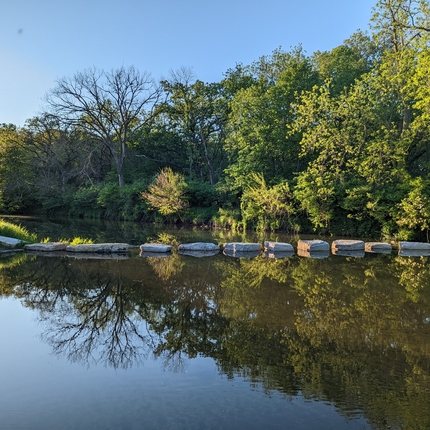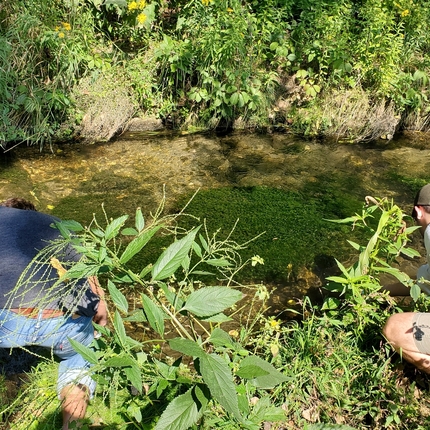By Kate Hansen, former staff member
In 2017, local leaders in eastern Iowa came together with goals to improve water quality, reduce flooding, and protect their drinking water. Five years later, the Maquoketa River Watershed Management Authority (WMA) has drummed up engagement from hundreds of community members, and is well-positioned to implement future projects.
The Maquoketa River WMA is one of Iowa’s 27 Watershed Management Authorities, coalitions of local leaders working together to advance water quality and flood resiliency in their communities. These entities are unique in that they are formed around natural watershed boundaries, rather than political boundaries.
Maquoketa River WMA members represent cities, counties, and soil and water conservation districts from the nine counties in the watershed—Fayette, Clayton, Buchanan, Delaware, Dubuque, Jones, Jackson, Clinton, and Linn.
Once formed, members began work to develop a watershed management plan—an evaluation of current conditions and a roadmap for future projects that would make an impact. Taking advantage of the watershed’s close proximity to the University of Iowa, the team also involved students in the process.
“In all, we worked with over 100 students and advisors,” said Erin Erickson, watershed coordinator for the Maquoketa River WMA. “To have so many projects underway, and to see the level of creativity and ideas they came up with, it was amazing.”
To begin, the collaborators surveyed more than 400 watershed residents, and hosted five focus group meetings. From the feedback, they identified top priorities among community members, including recreation, flooding, water quality, conservation, and education. They also collected extensive information about demographics, land use, topography, hydrology, flooding, water quality, and wildlife within the watershed.
In the next step of the planning process, graduate students from the School of Planning and Public Affairs worked in tandem with a technical committee. Technical advisors provided the students with everything from data to guidance, and included natural resource professionals, academic experts, state agency staff, emergency responders, and community members.
The Maquoketa River WMA was able to hire Erin as a full-time coordinator in July 2021. She is the WMA’s boots on the ground staff person responsible for the administration and implementation of projects, and has a strong conservation and natural resources background.
The plan’s second phase, which wrapped up in May, pinpointed priority areas and offered recommendations on where to focus future projects. The University of Iowa students analyzed information such as flooding risk, soil loss, recreation, and created profiles of the smaller watersheds within the Maquoketa. It also outlined a plan for implementation.
“The second phase looked at the data in a more scientific approach,” Erin said. “It focused on priority areas and helped answer the question of what to do next—how to utilize the data that was gathered. It includes water quality data, sediment information, maps, and profiles for the smaller watersheds within the Maquoketa.”
Other successful projects achieved alongside students included potable water master plan, engineering plans for floodplain and prairie restoration, an interactive map of the watershed, and a storytelling project about local transportation, flooding, and resilience. The Maquoketa River WMA also commissioned a short documentary-style film about the watershed by Department of Cinematic Arts student Andrew Senneff.
“The film includes interviews with stakeholders in the watershed, as well as original drone footage of the Maquoketa,” Erin said. “When the trailer came out, everybody was just blown away.”
Projects that involve the community have not stopped there. In 2019, a water sampling program was started. More than 20 volunteers sample 45 locations three times per year to evaluate conditions and trends.
“We have data from the last four years that provide a snapshot of all of our streams in our watershed,” Erin said. “The days of the sampling, the volunteers wake up early, collect their samples, and get them to the testing lab on time. Without those volunteers, it wouldn’t be possible.”
Erin and members of the Maquoketa River WMA know the work is just beginning. Most recently, Fine Arts students from the University of Iowa created and installed a mural at the Manchester Fish Hatchery. The WMA has also secured funding from the Iowa Department of Natural Resources to install more than 50 watershed signs, spanning eight counties, to increase public awareness of the watershed. In the longer term, they have their sights set on larger scale implementation of conservation practices.
“The WMA has been awaiting this moment when the watershed management plan is complete,” Erin said. “The next step is to find some funding to meet the community interest. Folks will come to us and say they want to increase their cover crops, put in a bioreactor, a saturated buffer, or an edge of field practice. I’m really looking forward to those future projects.”
To view the short film and learn more about the Maquoketa River WMA, visit maquoketariverwma.org.






